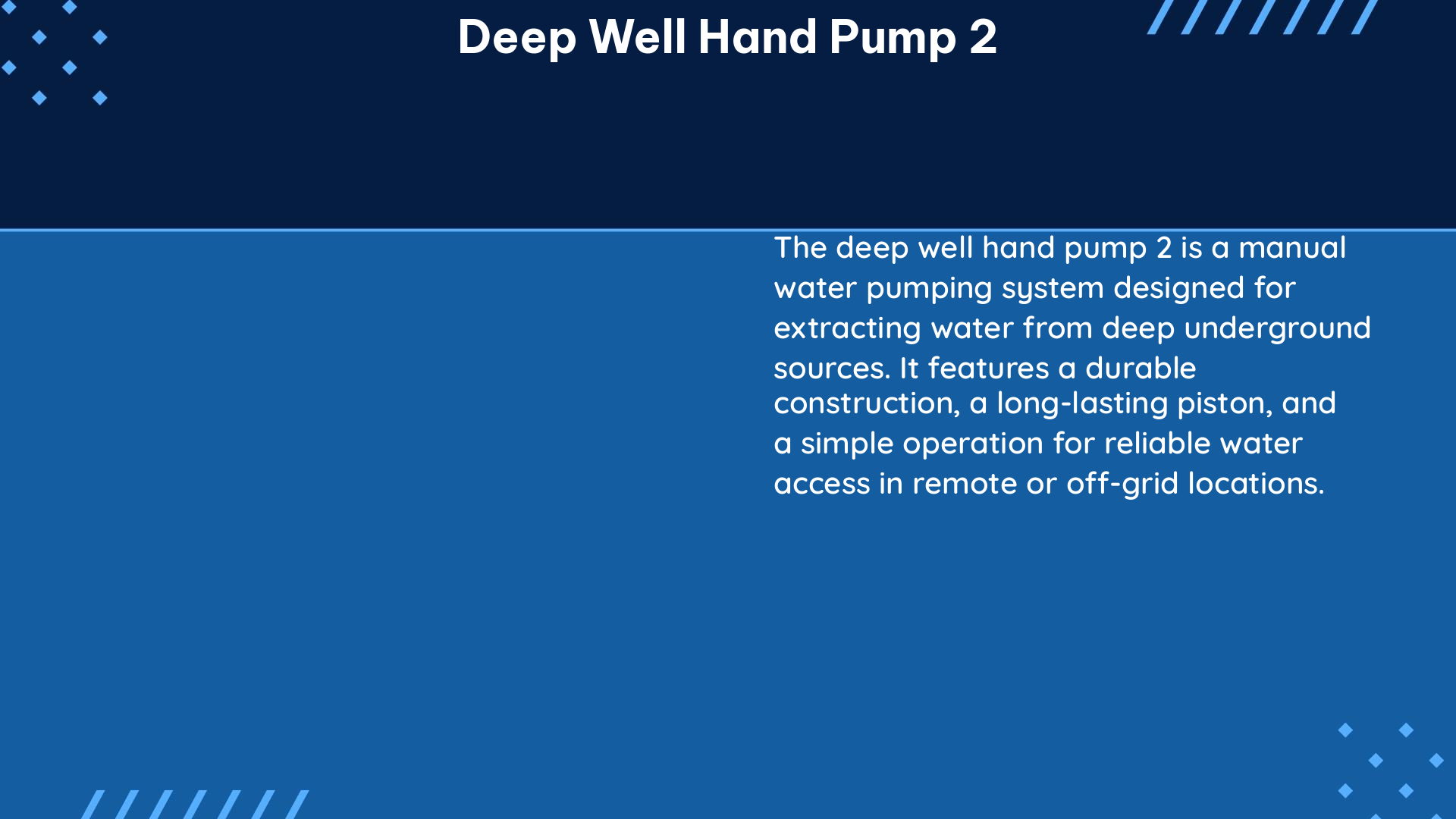A deep well hand pump 2 is a versatile and reliable solution for accessing groundwater from depths of up to 500 feet. Whether you’re living off-grid, in a remote location, or simply looking to supplement your water supply, this pump can be a game-changer. In this comprehensive guide, we’ll dive into the technical specifications, installation tips, and quantifiable data to help you make an informed decision and successfully install your own deep well hand pump 2.
Technical Specifications of Deep Well Hand Pump 2
The deep well hand pump 2 is designed to handle the challenges of extracting water from significant depths. Here are the key technical specifications you should know:
Pumping Depth
- The pump can lift water from a depth of up to 500 feet, making it suitable for a wide range of well depths.
- The maximum depth can vary depending on the model and manufacturer, with some high-end models capable of reaching depths of up to 650 feet.
Power Requirements
- The pump requires a minimum of 2 horsepower (hp) to generate around 350 pounds per square inch (psi) of pressure.
- The pump consumes approximately 1.5 kilowatts (kW) of power when operating.
- It can be powered by electricity, solar energy, or manual force, providing flexibility in off-grid or remote installations.
Pump Design
- The pump can be either submersible or above-ground, with the latter being a pump jack style that operates similarly to oil pumps.
- Submersible pumps are designed to be submerged in the well, while above-ground pumps are installed at the surface, connected to the well via a riser pipe.
Flow Rate
- A 1/2 horsepower (hp) pump can draw 6.9 amps and produce a flow rate of 4 to 5 gallons per minute (gpm).
- A solar-powered pump can produce a flow rate of up to 1 gpm and consume around 200 watts of power.
- A hand pump can produce a flow rate of up to 10 gpm, depending on the model and the user’s strength.
DIY Installation and Maintenance Tips

Proper installation and regular maintenance are crucial for the longevity and optimal performance of your deep well hand pump 2. Here are some essential DIY tips to consider:
Installation
- Ensure the pump is properly sized for the well and the water table to ensure optimal performance and prevent damage.
- Install the pump at the correct depth to maximize efficiency and prevent issues like pump cavitation or well dewatering.
- Use a qualified professional for the initial installation to ensure the pump is set up correctly and safely.
Maintenance
- Regularly inspect the pump and its components for any signs of wear or damage.
- Perform routine maintenance tasks, such as cleaning the pump, replacing worn parts, and lubricating moving components.
- Keep the pump area clean and free of debris to prevent clogging and ensure smooth operation.
- Consider upgrading to a smart handpump system, which can provide real-time data on pump performance and water usage, enabling proactive maintenance.
Quantifiable Data and Comparisons
To help you make an informed decision, let’s look at some quantifiable data and comparisons for deep well hand pump 2:
Power Consumption and Flow Rates
- A 1/2 horsepower (hp) pump can draw 6.9 amps and produce a flow rate of 4 to 5 gallons per minute (gpm).
- A solar-powered pump can produce a flow rate of up to 1 gpm and consume around 200 watts of power.
- A hand pump can produce a flow rate of up to 10 gpm, depending on the model and the user’s strength.
Depth Capabilities
- The deep well hand pump 2 can lift water from depths of up to 500 feet, with some high-end models reaching depths of up to 650 feet.
- In comparison, traditional shallow well hand pumps are typically limited to depths of around 25 feet.
Pressure Generation
- The deep well hand pump 2 can generate around 350 pounds per square inch (psi) of pressure, which is significantly higher than the 50-100 psi typically produced by shallow well hand pumps.
Maintenance Requirements
- Deep well hand pumps generally require more frequent maintenance compared to their shallow well counterparts due to the increased stress on the components.
- However, the use of smart handpump systems can help reduce maintenance costs and ensure reliable water delivery.
By understanding these technical specifications, installation tips, and quantifiable data, you’ll be well-equipped to select and install the right deep well hand pump 2 for your needs, whether you’re an off-grid enthusiast, a homesteader, or simply looking to supplement your water supply.
References:
- Water Rocket Booklet. National Physical Laboratory. https://www.npl.co.uk/skills-learning/outreach/water-rockets/wr_booklet_print.pdf
- Maximum depth for deep well hand pumps? Or “low” consumption electrical alternative. Reddit. https://www.reddit.com/r/OffGrid/comments/vpaio6/maximum_depth_for_deep_well_hand_pumps_or_low/
- Smart Handpump data helps deliver reliable drinking water – UKRI. UK Research and Innovation. https://www.ukri.org/who-we-are/how-we-are-doing/research-outcomes-and-impact/smart-handpump-data-helps-deliver-reliable-drinking-water/

The lambdageeks.com Core SME Team is a group of experienced subject matter experts from diverse scientific and technical fields including Physics, Chemistry, Technology,Electronics & Electrical Engineering, Automotive, Mechanical Engineering. Our team collaborates to create high-quality, well-researched articles on a wide range of science and technology topics for the lambdageeks.com website.
All Our Senior SME are having more than 7 Years of experience in the respective fields . They are either Working Industry Professionals or assocaited With different Universities. Refer Our Authors Page to get to know About our Core SMEs.